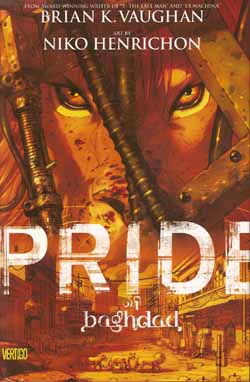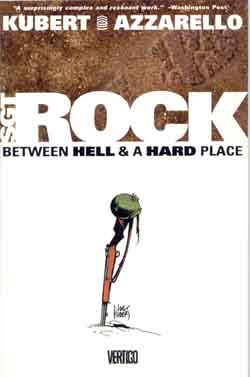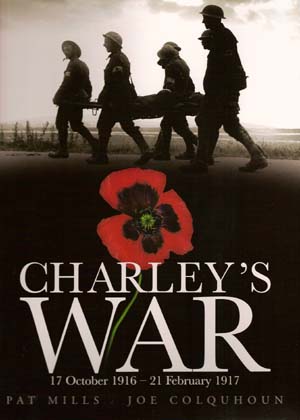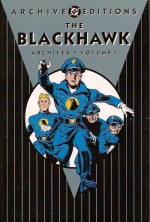
By Will Eisner, Chuck Cuidera, Reed Crandall & various (DC Comics)
ISBN: 1-56389-700-8
The early days of the American comicbook industry were awash with both opportunity and talent and these factors also coincided with a vast population hungry for cheap entertainment. Comics had no fans or collectors; only a large market-place open to all varied aspects of yarn-spinning and tale-telling. Thus, even though loudly isolationist and more than six months away from active inclusion in World War II, creators like Will Eisner and publishers like Everett M. (better known as “Busy”) Arnold felt that Americans were ready for the themed anthology title Military Comics.
Nobody was ready for Blackhawk.
Military Comics #1 launched on May 30th 1941 (with an August off-sale or cover-date) and included in its gritty, two-fisted line-up Death Patrol by Jack Cole, Miss America, Fred Guardineer’s Blue Tracer, X of the Underground, the Yankee Eagle, Q-Boat, Shot and Shell, Archie Atkins and Loops and Banks by “Bud Ernest” (actually aviation-nut and unsung comics genius Bob Powell), but none of the strips, not even Cole’s surreal and suicidal team of hell-bent fliers, had the instant cachet and sheer appeal of Eisner and Powell’s “Foreign Legion of the Air” led by the charismatic Dark Knight known only as Blackhawk.
Chuck Cuidera, already famed for creating The Blue Beetle for Fox, drew ‘the Origin of Blackhawk’ for the first issue, wherein a lone pilot fighting the Nazi invasion of Poland in 1939 was shot down by Nazi Ace Von Tepp, who then went on to bomb the farmhouse sheltering the pilot’s family. Rising from his plane’s wreckage the distraught pilot vows vengeance…
Two years later, with the Nazis in control of most of Europe Von Tepp’s unassailable position is threatened by a mysterious paramilitary squadron of unbeatable fliers, dedicated to crushing injustice and smashing the Axis war-machine…
Eisner wrote the first four Blackhawk episodes and Cuidera stayed aboard until issue #11 – although the artist would return in later years. Many of the stories were originally untitled but have been conveniently characterized with such stirring designations as issue #2’s ‘The Coward Dies Twice’ wherein the team – “the last free men of the conquered countries” offer a deserter from a Spitfire Squadron a chance to redeem himself…
The easy mix of patriotism, adventure and slapstick was magnified by the inclusion of Chop-Chop in ‘The Doomed Squadron’: a comedy Chinaman painful to see through modern eyes, but a stock type considered almost as mandatory as a heroic leading man in those dark days, and not just in comics. At least the man was a brave and formidable fighter both on the ground and in a plane.
‘Desert Death’ took the team to Suez for the first of many memorable Arabian adventures as Nazi agitators attempted to foment a revolution among the tribesmen that would destroy the British. This tale was also notable for the introduction of a type of sexy siren beloved of Eisner and Quality Comics that would populate the strip until DC bought the property in 1957. There was also a secret map of Blackhawk Island, mysterious base of the ebon-clad freedom fighters.
With issue #5 Dick French assumed the writing role and ‘Scavengers of Doom’ tells a biting tale of battlefield looters allied to a Nazi mastermind setting an inescapable trap for the heroic fliers. More importantly French began to provide distinct and discrete characters for the previously anonymous minor players. In #6 the rapidly gelling team joined the frantic hunt for a germ weapon the Gestapo were desperate to possess in the spectacular alpine adventure ‘The Vial of Death’ whilst #7 (the first issue released after America joined the War – although the stories had not yet caught up to reality) found the boys prowling the Mongolian Steppe on horseback to thwart ‘The Return of Genghis Khan’.
‘The Sunken Island of Death’ from #8 was a striking maritime romp as the warring powers battled to possess an island freshly risen from the Atlantic depths strategically equidistant between The US, Britain and Festung Europa (that’s what the Nazis called the fortress they had made of mainland Europe). Although complete in itself it was also the first of an experimental, thematic three-part saga that stretched the way comics stories were told.
There were many melodramatic touches that made the Blackhawks so memorable in the eyes of a wide-eyed populace of thrill-hungry kids. There was the cool, black leather uniforms and peaked caps. The unique – but real – Grumman F5F-1 Skyrocket planes they flew from their secret island base and their eerie battle-cry “Hawkaaaaa!” But perhaps the oddest idiosyncrasy to modern readers was that they had their own song which André, Stanislaus, Olaf, Chuck, Hendrickson and Chop-Chop would sing as they dived into battle. And just to be informative and inclusive the music and lyrics were published in this issue and are re-presented here – just remember this is written for seven really tough guys to sing while dodging bullets…
Military #9 led with ‘The Man in the Iron Mask’ as the team discovered that a fallen comrade did not actually die but was hideously disfigured saving them, whilst the next issue’s tale ‘Trapped in the Devil’s Oven’ was another desert adventure which focused on the new science of plastic surgery and restored said hero to full fighting trim. Issue #11, Cuidera’s last, saw the squadron turn their attention to Japan – as reality caught up with publishing schedules. Intriguingly, ‘Fury in the Philippines’ starts quietly with the entire team calmly discussing carrying on against the Nazis or switching their attentions to the Pacific Theatre of Operations, until comedy relief Chop-Chop sways the debaters with an impassioned stand. Though inarguably an offensive stereotype visually, the Chinese warrior was often given the best lines and most memorable actions. A subversive attempt to shake up those hide-bound prejudices, perhaps?
Notwithstanding, the resultant mission against the Japanese fleet was a cataclysmic Battle Royale, full of the kind of vicarious pay-back that demoralized Americans needed to see.
‘The Curse of Xanukhara’ added fantasy elements to the gritty mix of blood and iron as the team’s hunt for a stolen code book led them to occupied Borneo and even Tokyo; a classy espionage thriller that marked the start of a superlative run of thrillers illustrated by the incredible Reed Crandall. The artist’s realistic line and the graceful poise of his work – especially on exotic femmes fatale and trustworthy Girls-next-door – made his strips an absolute joy to behold.
‘Blackhawk vs. The Butcher’ (#13, November 1942) written by new regular scripter Bill Woolfolk returned the team to Nazi territory as a fleeing Countess turned the team’s attention to the most sadistic Gauleiter (Nazi regional leader in charge of a conquered territory) in the German Army. What follows is a spectacular saga of justice and righteous vengeance, whilst ‘Tondeleyo’ was a different kind of thriller as an exotic siren used her almost unholy allure to turn the entire team against each other.
The quasi-supernatural overtones held firm in the stirring ‘Men Who Never Came Back’ when the team travelled to India to foil a Japanese plot, in a portmanteau tale narrated by three witches, Trouble Terror and Mystery, eerily presaging the EC horror classics that would cement Crandall’s artistic reputation more than a decade later.
‘Blackhawk vs. the Fox’ pitted the heroes against a Nazi strategic wizard (a clear reference to the epic victories of Erwin Rommel) in the burning sands of Libya, one of the most authentic battle tales in the canon, and this volume concludes with a racy tale of vengeance and tragedy as Japanese traitor Yoshi uses her wiles to punish the military government of Nippon, with Blackhawk as her unwitting tool in ‘The Golden Bell of Soong-Toy!’
These stories were produced at a pivotal moment in both comics and world history, a blend of weary sophistication and glorious, juvenile bravado. Like the best movies of the time, Casablanca, Foreign Correspondent, Freedom Radio, Captain of the Clouds, The Day Will Dawn, The First of the Few, In Which we Serve and all the rest with their understated, overblown way of accepting duty and loss, these rousing tales of the miracles that good men can do are some of the Golden Age’s finest moments. In fact these are some of the best comics stories of their time and I sincerely wish DC had proceeded with further collections. And so will you…
© 1941-1942, 2001 DC Comics. All Rights Reserved.
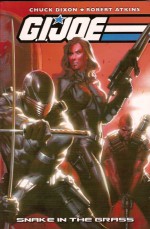

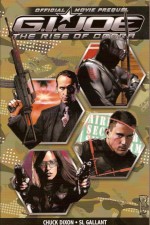

 Â
 